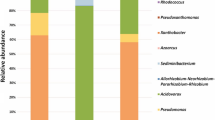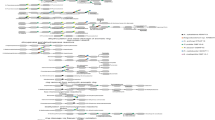Abstract
Bacteria of the Thauera genus have been described as important aromatic compound degraders and have attracted increased attention. In this study, three Thauera strains (Q4, Q20-C, and 3–35) were isolated from a coking wastewater treatment plant (WWTP) with a high abundance of Thauera. The 16S rRNA, nitrite reductase, and phenol hydroxylase (LmPH) genes and pollutant-degrading capacity of these strains were characterized and compared. Their 16S rRNA gene sequences were identical, but the genomic structures differed, as demonstrated by distinct enterobacterial repetitive intergenic consensus sequence PCR profiles with a similarity of less than 0.65. The analysis of degradation of coking wastewater by these strains showed that most of the main organic pollutants—phenol, methylphenol, and indole, but not quinoline—were degraded under aerobic conditions. These strains contained different LmPHs genes and showed different phenol degradation rates (Q4 > 3–35 > Q20-C). The presence of a microdiversity of Thauera spp. implies the existence of various finely differentiated niches in the industrial WWTP. The capacity of the Thauera strains to degrade a wide spectrum of aromatic compounds suggests their potential in bioremediation applications targeting aromatic pollutant-containing wastewater.




Similar content being viewed by others
References
Anders HJ, Kaetzke A, Kampfer P, Ludwig W, Fuchs G (1995) Taxonomic position of aromatic-degrading denitrifying pseudomonad strains K 172 and KB 740 and their description as new members of the genera Thauera, as Thauera aromatica sp. nov., and Azoarcus, as Azoarcus evansii sp. nov., respectively, members of the beta subclass of the Proteobacteria. Int J Syst Bacteriol 45:327–333
Beiko RG, Harlow TJ, Ragan MA (2005) Highways of gene sharing in prokaryotes. Proc Natl Acad Sci USA 102:14332–14337
Braker G, Fesefeldt A, Witzel KP (1998) Development of PCR primer systems for amplification of nitrite reductase genes (nirK and nirS) to detect denitrifying bacteria in environmental samples. Appl Environ Microbiol 64:3769–3775
Foss S, Harder J (1998) Thauera linaloolentis sp. nov. and Thauera terpenica sp. nov., isolated on oxygen-containing monoterpenes (linalool, menthol, and eucalyptol) nitrate. Syst Appl Microbiol 21:365–373
Futamata H, Harayama S, Watanabe K (2001) Group-specific monitoring of phenol hydroxylase genes for a functional assessment of phenol-stimulated trichloroethylene bioremediation. Appl Environ Microbiol 67:4671–4677
Gillings M, Holley M (1997) Repetitive element PCR fingerprinting (rep-PCR) using enterobacterial repetitive intergenic consensus (ERIC) primers is not necessarily directed at ERIC elements. Lett Appl Microbiol 25:17–21
Harwood CS, Burchhardt G, Herrmann H, Fuchs G (1998) Anaerobic metabolism of aromatic compounds via the benzoyl-CoA pathway. FEMS Microbiol Rev 22:439–458
Jaspers E, Overmann J (2004) Ecological significance of microdiversity: identical 16S rRNA gene sequences can be found in bacteria with highly divergent genomes and ecophysiologies. Appl Environ Microbiol 70:4831–4839
Liu B, Zhang F, Feng X, Liu Y, Yan X, Zhang X et al (2006) Thauera and Azoarcus as functionally important genera in a denitrifying quinoline-removal bioreactor as revealed by microbial community structure comparison. FEMS Microbiol Ecol 55:274–286
Manefield M, Whiteley AS, Griffiths RI, Bailey MJ (2002) RNA stable isotope probing, a novel means of linking microbial community function to phylogeny. Appl Environ Microbiol 68:5367–5373
Mao Y, Zhang X, Zhang B, Zhao L (2008) Specific-PCR and denaturing gradient gel electrophoresis assisting isolation of Thauera spp. from a coking wastewater treatment plant. Acta Microbiologica Sinica (Wei Sheng Wu Xue Bao) 48:1634–1641
Mao Y, Zhang X, Yan X, Liu B, Zhao L (2008) Development of group-specific PCR-DGGE fingerprinting for monitoring structural changes of Thauera spp. in an industrial wastewater treatment plant responding to operational perturbations. J Microbiol Methods 75:231–236
Mechichi T, Stackebrandt E, Gad’on N, Fuchs G (2002) Phylogenetic and metabolic diversity of bacteria degrading aromatic compounds under denitrifying conditions, and description of Thauera phenylacetica sp. nov., Thauera aminoaromatica sp. nov., and Azoarcus buckelii sp. nov. Arch Microbiol 178:26–35
Probian C, Wulfing A, Harder J (2003) Anaerobic mineralization of quaternary carbon atoms: isolation of denitrifying bacteria on pivalic acid (2,2-dimethylpropionic acid). Appl Environ Microbiol 69:1866–1870
Rivera IG, Chowdhury MA, Huq A, Jacobs D, Martins MT, Colwell RR (1995) Enterobacterial repetitive intergenic consensus sequences and the PCR to generate fingerprints of genomic DNAs from Vibrio cholerae O1, O139, and non-O1 strains. Appl Environ Microbiol 61:2898–2904
Satoh H, Yamakawa T, Kindaichi T, Ito T, Okabe S (2006) Community structures and activities of nitrifying and denitrifying bacteria in industrial wastewater-treating biofilms. Biotechnol Bioeng 94:762–772
Scholten E, Lukow T, Auling G, Kroppenstedt RM, Rainey FA, Diekmann H (1999) Thauera mechernichensis sp. nov., an aerobic denitrifier from a leachate treatment plant. Int J Syst Bacteriol 49 Pt 3:1045–1051
Shinoda Y, Sakai Y, Uenishi H, Uchihashi Y, Hiraishi A, Yukawa H et al (2004) Aerobic and anaerobic toluene degradation by a newly isolated denitrifying bacterium, Thauera sp. strain DNT-1. Appl Environ Microbiol 70:1385–1392
Song B, Palleroni NJ, Haggblom MM (2000) Description of strain 3CB-1, a genomovar of Thauera aromatica, capable of degrading 3-chlorobenzoate coupled to nitrate reduction. Int J Syst Evol Microbiol 50 Pt 2:551–558
Song B, Palleroni NJ, Kerkhof LJ, Haggblom MM (2001) Characterization of halobenzoate-degrading, denitrifying Azoarcus and Thauera isolates and description of Thauera chlorobenzoica sp. nov. Int J Syst Evol Microbiol 51:589–602
Thomsen TR, Kong Y, Nielsen PH (2007) Ecophysiology of abundant denitrifying bacteria in activated sludge. FEMS Microbiol Ecol 60:370–382
Valle A, Bailey MJ, Whiteley AS, Manefield M (2004) N-acyl-l-homoserine lactones (AHLs) affect microbial community composition and function in activated sludge. Environ Microbiol 6:424–433
Zhang M, Tay JH, Qian Y, Gu XS (1998) Coke plant wastewater treatment by fixed biofilm system for COD and NH3-N removal. Water Res 32:519–527
Zoetendal EG, Akkermans ADL, De Vos WM (1998) Temperature gradient gel electrophoresis analysis of 16S rRNA from human fecal samples reveals stable and host-specific communities of active bacteria. Appl Environ Microbiol 64:3854–3859
Acknowledgments
This research was financially supported by the National Natural Science Foundation of China (NSFC 20677041), and National “863” High-tech R&D Program (2007AA021301), the Shanghai Leading Academic Discipline Project (B203), and the project 05SR07107 sponsored by Shanghai-Rhone bilateral collaboration research.
Author information
Authors and Affiliations
Corresponding author
Rights and permissions
About this article
Cite this article
Mao, Y., Zhang, X., Xia, X. et al. Versatile aromatic compound-degrading capacity and microdiversity of Thauera strains isolated from a coking wastewater treatment bioreactor. J Ind Microbiol Biotechnol 37, 927–934 (2010). https://doi.org/10.1007/s10295-010-0740-7
Received:
Accepted:
Published:
Issue Date:
DOI: https://doi.org/10.1007/s10295-010-0740-7




